 The Zinn Education Project was honored to be included in “Howard Zinn: A Lifetime of Teaching, Writing, and Activism,” a daylong symposium held at New York University (NYU) on April 24, 2014. The event celebrated the generous donation of Zinn’s personal papers to NYU’s Tamiment Library by his children, Myla Kabat-Zinn and Jeff Zinn. Included in the donation are Zinn’s personal correspondences, school and military records, FBI files, datebooks, biographical articles, and interviews.
The Zinn Education Project was honored to be included in “Howard Zinn: A Lifetime of Teaching, Writing, and Activism,” a daylong symposium held at New York University (NYU) on April 24, 2014. The event celebrated the generous donation of Zinn’s personal papers to NYU’s Tamiment Library by his children, Myla Kabat-Zinn and Jeff Zinn. Included in the donation are Zinn’s personal correspondences, school and military records, FBI files, datebooks, biographical articles, and interviews.
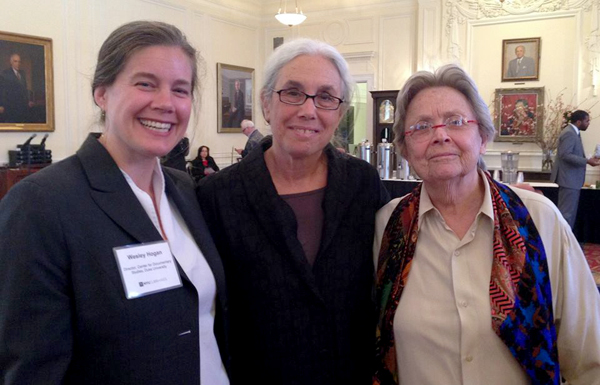
Wesley Hogan (Zinn as Historian panelist), Myla Kabat-Zinn (Howard Zinn’s daughter), and Marilyn Young (co-planner of the symposium).
Panels held throughout the day highlighted different aspects of Zinn’s life and work: Zinn as Historian, Zinn as Activist, and Teaching Zinn. Activists, scholars, and teachers, many who knew Zinn personally, shared their research, memories, and pedagogy inspired by our favorite people’s historian.
In the opening panel, Zinn at Tamiment, two NYU undergraduate students shared their use of the newly acquired archive for research. Rustin Finkler, a senior at NYU’s Steinhardt School of Culture, Education, and Human Development, described the harassment Zinn received at both Spelman College and Boston University for his scholarship and activism. Kristin Catrone, also a senior at Steinhardt, shared some of Zinn’s correspondences with prison inmates, which include more than 200 letters Zinn received from prisoners throughout his lifetime.
Catrone reminded the audience of one of Zinn’s lesser-known works, Justice in Everyday Life, in which he critiques the role of prisons in society.
Prisons cannot be reformed, any more than slavery can be reformed. They have to be abolished. And yet, they will not be abolished until society is changed, until people think differently about punishment, about law, about crime, about violence, about property, about human beings. They will not be abolished until society works differently: until wealth is equally distributed, and people don’t live in slums, and the motivations for crime and punishment become very weak, and the desire to live cooperatively with other people becomes very strong.
As Catrone noted, Zinn’s letters from prisoners illustrate how deeply committed to activism Zinn was in both his professional and private life. She also shared a recommendation letter Zinn wrote for an inmate’s release. In it he wrote: “I have written hundreds of letters of recommendation in my life, mostly for students who have sought admission to various graduate schools and professional schools. I consider this letter perhaps the most important one I have ever written.” Comments like this one, as Catrone noted, make clear Zinn’s commitment to justice and freedom both inside and outside the classroom. Also included in the panel were Frances Fox Piven, professor of political science and sociology at the City University of New York’s Graduate Center; Jan Hilley, Civil Liberties/Academic Freedom Project Archivist, NYU; and Robert Cohen, professor of history and social studies at NYU’s Steinhardt School of Culture, Education, and Human Development.
In the Zinn as Historian panel, Robyn Spencer gave a moving talk titled “Howard and Me.” In it, she shared her experiences as a black woman undergraduate who was assigned Zinn in a history course, explaining how his work helped her find her own voice and paved the way for her future scholarship. Wesley Hogan, director of the Center for Documentary Studies at Duke University, provided insight into Zinn’s work with the Student Nonviolent Coordinating Committee (SNCC).
Writer and activist Alice Walker shared her personal memories of her friendship with “Howie,” as she affectionately called him during the Zinn as Activist panel. “In my little community of Putnam County, Georgia, we honestly thought that there was no such thing as a good white man,” she recalled. “Sure, once in a while someone would posit Santa Claus and Jesus as the only real possibilities. But when I was sitting next to Howie [at an event at Spelman College] I realized that he was the first white person I liked. He did not feel in the least white. What is it that made him not a white man? It’s worth pondering.”
She also said, “It’s unbelievable the impact a teacher like Howie can have in a young person’s life. It’s so rare to have an adult tell you the truth, or to be right there on the picket line with you, ready to go to jail with you, ready to take his turn under the ax handle with you.” The panel also included NYU history professor Marilyn Young, Martin Duberman, professor emeritus of history at Lehman College and the CUNY Graduate Center, and Irene Gendzier, professor emeritus at Boston University.
Stepping out of the panel format, the Zinn Education Project (ZEP) turned “Teaching Zinn” into an interactive workshop on the power of people’s pedagogy. Alice Walker provided context to the session by describing the influence that a people’s history approach has had in her own life.
Julian Hipkins III, a U.S. history teacher in Washington D.C., led the group in interactive activity from a lesson on the U.S.-Mexico War by Bill Bigelow. After participants experienced the teaching of people’s history in action, they watched a video clip of students engaged in a Zinn Education Project lesson in Hipkins’ classroom.
Katy Swalwell, assistant professor of education at University of Maryland and ZEP fellow, provided an overview of a national survey she is conducting on the teaching of people’s history and the impact of the Zinn Education Project.
Carl Mirra, associate professor of education at Adelphi University, eloquently summarized why so many scholars, students, teachers, and activists continue to find inspiration from Zinn:
Howard Zinn is often incorrectly portrayed as having a fixed, unchanging worldview. But, he underwent a significant transformation: from volunteer bombardier in WWII to antiwar, anti-imperialist activist. I see him as part of an understudied tradition of GI dissent, soldiers whose combat experience turned them against war. Zinn noted that as a fighter pilot he saw the ground war at a distance, in an impersonal way. He did not see the people, the dead bodies, including the disfigurement of children and innocent civilians.
He later learned that the bombs he dropped on a French town, Royan, killed many innocent people. But from the sky he could not hear their cries, their screams, or see the horror. He participated at 10,000 feet. However, he would refuse to understand history, or injustice, from 10,000 feet. Zinn, along with a movement of activist-scholars, enabled us to understand the struggles, the cries and screams, of ordinary people in history from the ground, from the bottom up, as they put it.

William Katz, author of “Black Indians,” during the interactive activity on the U.S.-Mexico War.
In addition to the panel participants, there were a number of other movers and shakers in the people’s history community in attendance: William Loren Katz, author of Black Indians: A Hidden Heritage, along with 40 other books; Myla and Jon Kabat-Zinn; SNCC veterans Dorothy Zellner and Dinky Romilly; and more.
The preservation of Howard Zinn’s papers at NYU’s Tamiment Library allows future generations the opportunity to continue drawing inspiration from his idealism, generosity, and love for humanity that has inspired countless students and educators.
View more photos from the event on the Zinn Education Project Facebook album.

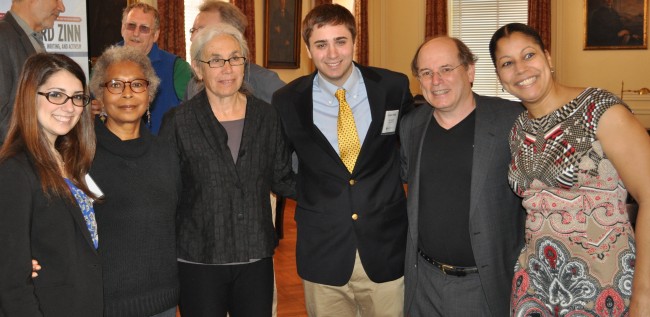
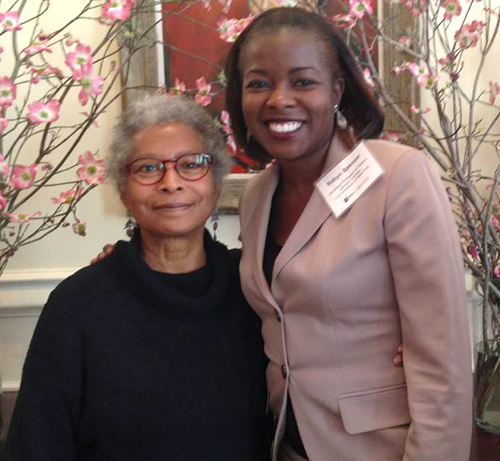
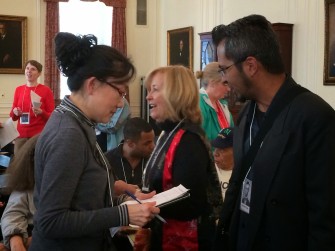
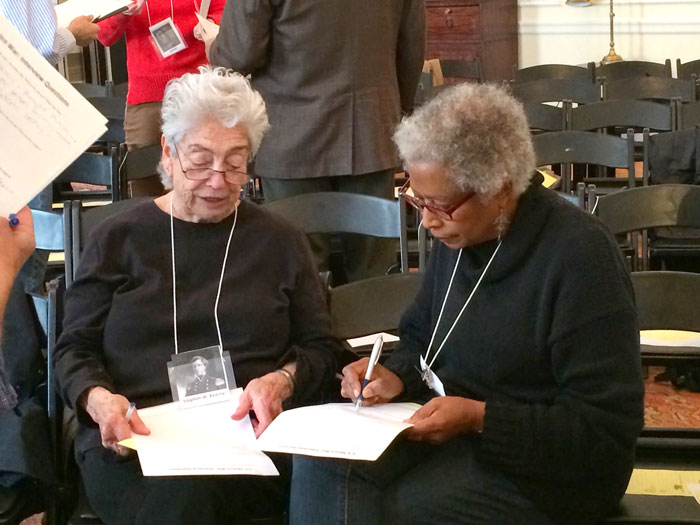





Wow, at 72 years old, and as well read as I am, I was unaware of the existence and great life of Howard Zinn. Now I have a whole new reading list for the upcoming year(s) . I thank Bill Moyer for mentioning Howard Zinn on facebook.